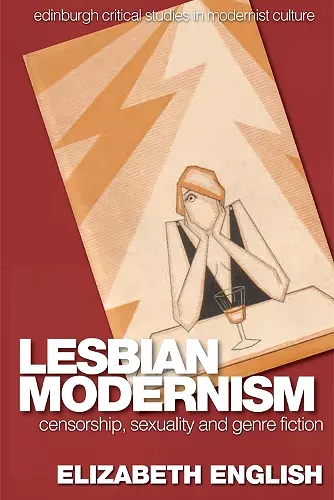Lesbian Modernism
Censorship, Sexuality and Genre Fiction
Format:Paperback
Publisher:Edinburgh University Press
Published:30th Apr '17
Currently unavailable, and unfortunately no date known when it will be back

Rethinks the lesbian modernist project to demonstrate that genre fiction not only influenced modernist writers such as Woolf and Stein but also found its way into their ostensibly highbrow work. Brings to light hitherto neglected mainstream writers working in popular genres who contributed to the lesbian modernist aesthetic. Situates Katharine Burdekin within the context of lesbian modernism for the first time, employing hitherto unseen archive material (including letters and manuscripts). Divided into three broad multi-author genres (fantasy, historical and detective fictions), the study covers popular fictions such as utopian writing, the supernatural, historical biography, historical romance, and the classic country-house crime novel.
Popular fiction is seen as a staple of late-twentieth-century and contemporary lesbian cultural production, however largely perceived as a recent development. Elizabeth English breaks new ground by providing a pre-history to lesbian cultural identity.The first book-length study to explore the importance of genre fiction for the body of literature we call lesbian modernism Elizabeth English explores the aesthetic dilemma prompted by the censorship of Radclyffe Hall’s novel The Well of Loneliness in 1928. Faced with legal and financial reprisals, women writers were forced to question how they might represent lesbian identity and desire. Modernist experimentation has often been seen as a response to this problem, but English breaks new ground by arguing that popular genre fictions offered a creative strategy against the threat of detection and punishment. Her study examines a range of responses to this dilemma by offering illuminating close readings of fantasy, crime, and historical fictions written by both mainstream and modernist authors. English introduces hitherto neglected women writers from diverse backgrounds and draws on archival material examined here for the first time to remap the topography of 1920s-1940s lesbian literature and to reevaluate the definition of lesbian modernism. Key Features: Rethinks the lesbian modernist project to demonstrate that genre fiction not only influenced modernist writers such as Woolf and Stein but also found its way into their ostensibly highbrow workBrings to light hitherto neglected mainstream writers working in popular genres who contributed to the lesbian modernist aestheticSituates Katharine Burdekin within the context of lesbian modernism for the first time, employing hitherto unseen archive material (including letters and manuscripts)Divided into three broad multi-author genres (fantasy, historical and detective fictions), the study covers popular fictions such as utopian writing, the supernatural, historical biography, historical romance, and the classic country-house crime novel
Lesbian Modernism pits highbrow modernist experimentation against popular genre fiction to offer fresh perspectives on the literary representation of Sapphic love. Conceptually ambitious and deeply researched, this study exposes the ways some women writers evaded the censor by exploiting the fissures of the literary marketplace. * Laura Doan, author of Disturbing Practices: History, Sexuality, and Women’s Experience of Modern War *
ISBN: 9781474424493
Dimensions: unknown
Weight: 376g
224 pages